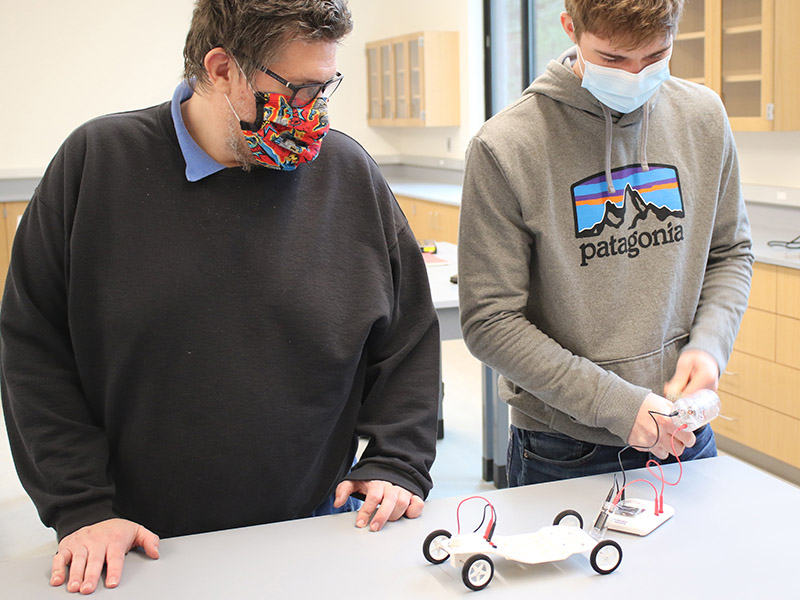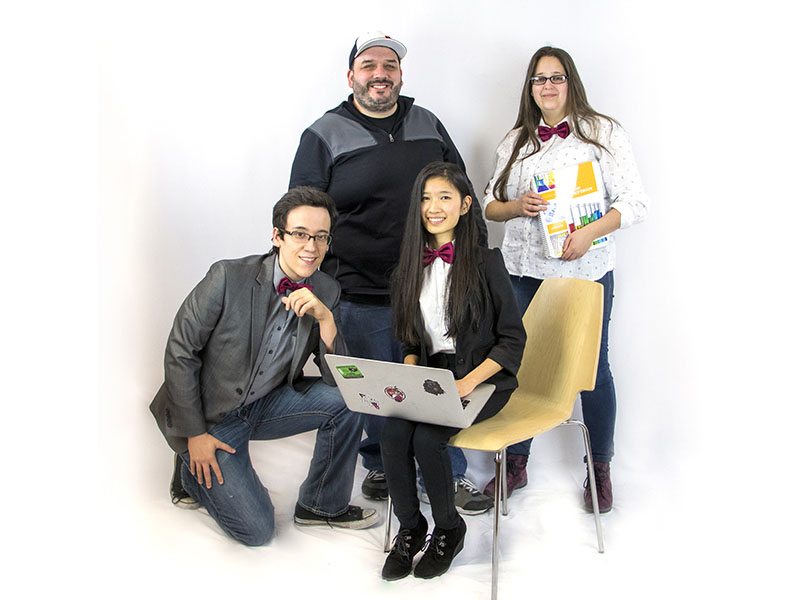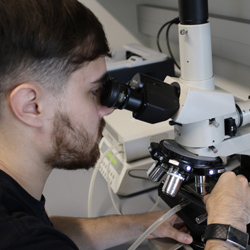
May 16, 2022 | News
Students lead energy research project
In the 1940s, Sci-Fi writer Isaac Asimov envisioned humans harvesting solar power in space and sending it down to power people’s needs on Earth. Engineers are still working on that one.
What if scientists could create better solar panels here on Earth? What if it could be in the form of an ultra-thin organic film? No, not like growing organic lettuce, more like organic wiring.
A team of chemistry students are experimenting with ways to create exactly that, under the guidance of chemistry professor Dr. Mike Springer.
SWOCC researchers today
“Theoretically we could use it for like replacing windows so they can harness energy. Or you can put it on roof shingles or paint it on the side of your house so the whole house can propagate energy,” explained student Bobby Rodriguez.
The 24-year-old is on a degree pathway from SWOCC to Oregon State, and then a career in solar or nuclear energy innovation. Rodriguez is often perched on stool beside a microscope, mixing liquid crystals into a solution, placing it on a glass slide. He then spins the slide at 7500 rpms, creating thin films. The goal is to optically align the crystals so electricity conducts through them.
“The liquid crystals are just beautiful to observe under the microscope,” said Julia Graves, a second-year student on a medical degree pathway.
Tomorrow’s teachers and healers
Each team member brings different skills to the group, and takes on various tasks preparing them for transfer to Oregon’s universities and then science-based careers.
Graves reviews literature and presents to group members. It’s helping her understand scientific documentation, formatting and research techniques. She expects to use these skills when she ultimately graduates as a physician assistant to work somewhere in rural Oregon.
“The whole reason I went back to school was I learned about the primary care physician shortage particularly in rural Oregon. I want to be a part of that solution,” Graves said, who joined the research team to be active and involved on campus.
Fellow researcher Zachary Dickinson got a SWOCC Foundation scholarship and came to SWOCC to compete on the swim team. On a science degree pathway, curiosity lured him into this Oregon NASA Space Grant funded research project. An aspiring chemistry teacher, Dickinson has thrived with the open friendliness and ability to problem-solve with co-researchers and Dr. Springer.
Graves agreed, “It’s been a great experience. I know Dr. Springer is hoping this research will build on itself year after year. It’s a fantastic experience for students who are interested.”
That’s the goal. And who knows, the crystals might align perfectly for SWOCC’s research team to help invent the next generation of affordable, organic solar power technology.
Learn about Chemistry career pathways: Text or Call 541-240-8227 SWOCCbound@socc.edu or visit https://www.socc.edu/chemistry-2/.

Dec 6, 2021 | Curry Campus, News
Coos Bay, OR – The Oregon NASA Space Grant Consortium’s Faculty Research Award Program has announced it is investing $123,000 in Southwestern Oregon Community College’s Chemistry and Physics/Engineering PRISMS (Providing Research Infrastructure in Space and Material Sciences) project.
This two-year grant will fund faculty and undergraduate research projects, taking advantage of the modern, high-tech laboratories and equipment at Southwestern’s newly opened Umpqua Hall.
“This is a great win for our college. The grant opens the door to top-notch, interactive research opportunities for students at the beginning of their college journey,” said Dr. Aaron Coyner, Associate Professor of Physics/Engineering. “Gaining research experience as an undergraduate shortens the learning curve for science majors as they move on to Southwestern’s partner universities, graduate school or a career in a STEM field.”
Dr. Coyner is a principal faculty coordinator for the PRISMS project, along with Dr. Michael Springer, Associate Professor of Chemistry. They will work do the research side-by-side with their students.
The PRISMS projects creates opportunities for students to do structured, hands-on research and work on publishable discoveries in space physics and material sciences.
The PRISMS projects include research in:
• Modeling and characterization of charged particles that come into the Earth’s interplanetary environment;
• Development and synthesis of new liquid crystal materials for use in flexible solar cells;
• Discovery, analysis and classification of possible micrometeorites found on our coast; and
• Identification and discovery of potential near-Earth asteroids as part of the International Astronomical Search Collaboration (IASC)
Through their research projects, Southwestern’s physics and chemistry students will explore fundamental questions about the origin and composition of matter and radiation that exist in the space between the star systems in our galaxy, and how they interact with Solar wind and Solar energetic events. Students will also get to see and work on analytical studies of micrometeorites and near-Earth asteroid identification. They also will dive into research on liquid crystal photovoltaic cells with the intent of developing self-organizing and self-healing solar cell materials.
Students also are using a state-of-the-art ‘microscope for molecules’ to do university-level, hands-on analysis and research. Special thanks go to Dennis and Janet Beetham who donated the NMR spectrometer for the chemistry department.
“Participating in research is an essential component of learning in a STEM field. Numerous studies have shown a strong correlation between student research and success in STEM,” said Dr. Mike Springer.
This grant provides critical support to facilitate publishable STEM research at Southwestern and allows for a stronger outreach connection to K-12 students and teachers on the south Oregon coast, from Brookings to Reedsport. The College science faculty, in collaboration with students, are looking forward to sharing the results of their research with the community in the future.

Jul 22, 2019 | News
When Rose Garrett and Tyrone Stagner graduated in 2018, it was a bit of a surprise to see this dynamic science duo back on our Coos Campus in 2019. Some students just can’t get enough of Southwestern’s science classes.
“It makes a huge difference being able to have a small class and ask those questions,” Tyrone said. “I realized how valuable it was to take the classes here with Dr. Coyner, Dr. Springer and Dr. K.”
Our STARS shine in state competition
That fascination with physics, chemistry and math prompted Rose and Tyrone to pull together SWOCC’s 2019 InventOR team, with students Korina Shipstad and Austin Friedrich. InventOR is a statewide invention competition for college students to develop solutions to problems they see in their communities.
You might have read about our team. They created a prototype for Self Tightening And Retractable Shoes or STARS. Southwestern made it to the final round of the InventOR competition. They didn’t win, but it was worth the experience.
“We learned as a group that everybody has ideas, and everybody butts heads. You have to listen to everybody’s ideas to really try to figure out what’s going to work best,” Tyrone said.
Southwestern propels duo to university programs
Both are headed to universities – Rose in chemical engineering and Tyrone in electrical/software engineering. So far, they’ve been able to pay for school with scholarships, financial aid, PELL grants and tuition waivers for working in student government on campus. Ultimately, Rose and Tyrone want their masters degrees, so they can work in research and discovery.
“It’d be cool to work for NASA or SpaceX or Google,” Rose said.
No surprise there. Both are already well on their way to inventing products for the future.







